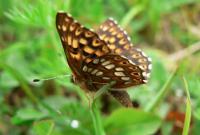The Duke of Burgundy (Gullvivefjäril)

The Duke of Burgundy (Hamearis lucina) is a small butterfly with remaining populations in most parts of Europe, even though it is declining rapidly in many places. In Sweden it exists in a few places in the southeastern part of the country, with the strongest populations found in Östergötland, southeastern Småland and on the island of Öland (ArtDatabanken 2005). One of the largest mainland populations in Sweden is probably located at Omberg (Kruys 1998).
This butterfly is mostly found in bushlands, e.g. former pastures or lightly grazed land where the host plant cowslip (Primula veris) is found. The wings of the butterfly are dark brown with light yellowish brown and white spots and a wingspan of 25-29 mm (ArtDatabanken 2005).
The flight period is commonly from the beginning of June and a couple of weeks ahead, depending on the weather conditions. Males hatch first, choose a territory and defend it until they find a female to mate with (ArtDatabanken 2005). The females are harder to observe even though they move around more. They lay their eggs singly or in small groups of up to eight on the underside of the leaves (Emmet & Heath 1989). The eggs hatch after 10-20 days and the larvae emerge and start eating. After 4-6 weeks they pupate and overwinter in a dry, hidden site just above ground level in e.g. empty beechnut cases (ArtDatabanken 2005).
References
ArtDatabanken, Sveriges lantbruksuniversitet (2005) Nationalnyckeln till Sveriges flora och fauna; Fjärilar: Dagfjärilar. Ruter Media Group, Laholm.
Emmet AM & Heath J (1989) The moths and butterflies of Great Britain and Ireland, vol 7, part 1, Hesperiidae-Nymphalidae the butterflies. Harley books, Colchester.
Kruys I (1998) The Duke of Burgundy Butterfly (Hamearis lucina Linneaus 1758). Observations regarding its ecology on Omberg in Östergötland, Sweden. Entomologisk Tidskrift 119: 2, 77-82.
Responsible for this page:
Director of undergraduate studies Biology
Last updated:
05/31/06
